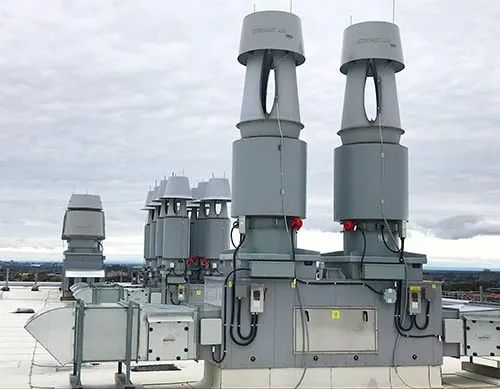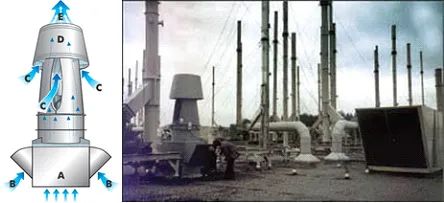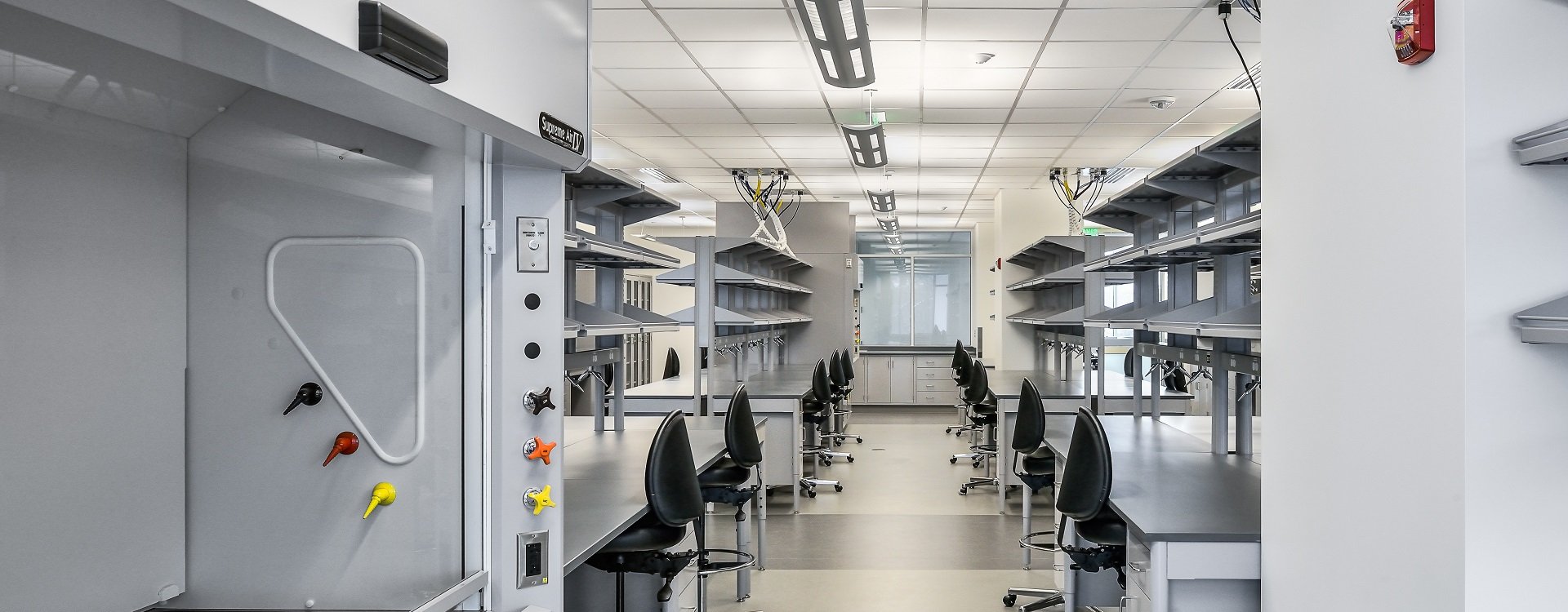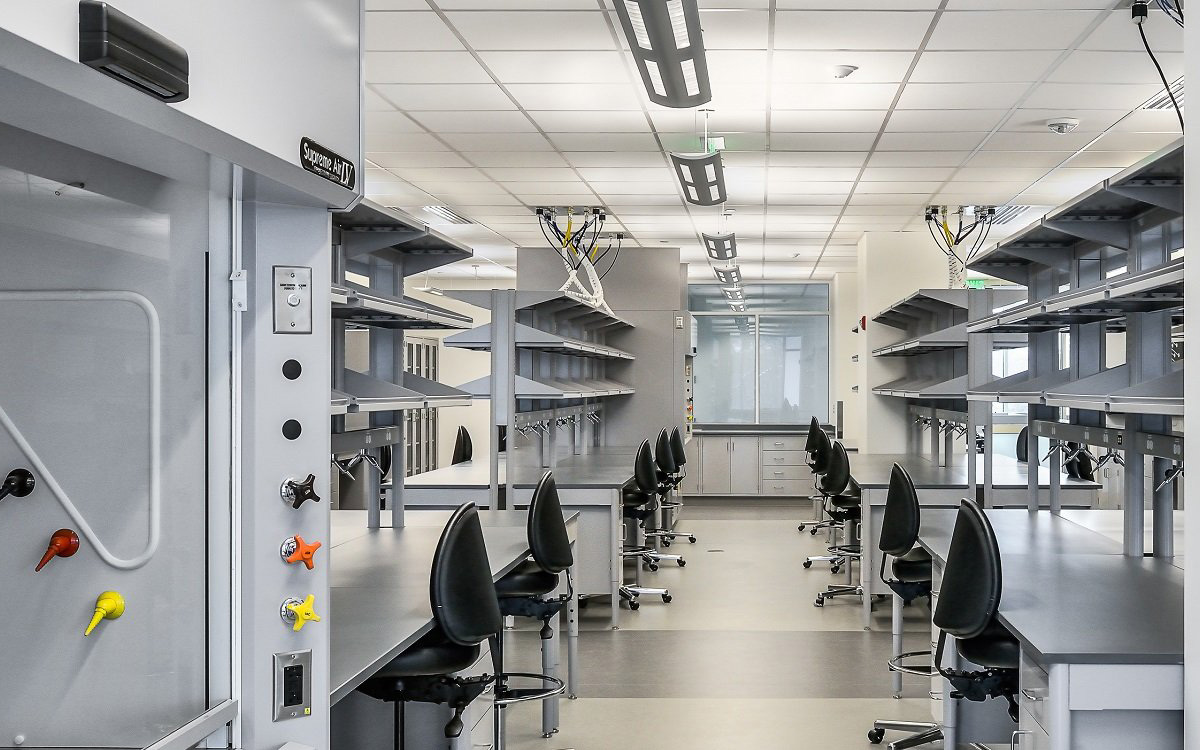Problems to Be Considered in Designing Laboratory Exhaust System
Date: 2022-01-19 Source: RUANQI Classification: Resources
As a part of chemical research facilities, the exhaust system of laboratory fume hood is usually taken for granted. However, when designing or configuring the laboratory, the choice of exhaust system may have a great impact on the safety of the personnel in the laboratory building and nearby buildings. The selection of fume hood exhaust system will also affect the long-term operation cost of the building.
A deeper understanding of various types of exhaust systems and their operation can eliminate major safety problems that may occur in the future, and at the same time optimize the efficiency of buildings and the reliability of systems.
Basic principle of exhaust system
The main purpose of exhaust system of laboratory fume hood is to remove polluted air produced by chemical vapor, chemical reaction and other laboratory activities. The system must provide maximum protection while using as little air as possible. It must control the flow of two kinds of air: laboratory exhaust and clean air instead of it.
When designing new laboratory facilities or upgrading existing laboratory facilities, the most important considerations about fume hood exhaust system are safety (about secondary entrainment of laboratory waste gas into buildings or adjacent buildings) and indoor air quality to protect building residents. In addition, the ability of the system to meet the appropriate pollution control standards (including eliminating the unpleasant smell in the discharge stream) is also a key consideration.
Other important considerations include system efficiency, initial and operating costs, and roof aesthetics (Figure 1). For example, the quiet and vibration-free performance is very important for protecting precision laboratory instruments.

Fig. 1. The beauty of the roof is one of the many considerations when choosing the fume hood exhaust system of laboratory equipment
Before choosing the exhaust system of laboratory fume hood, the position of fume hood should be carefully considered. Its location will seriously affect efficiency and security. For example, people in the laboratory can generate air turbulence just by walking through the fume hood, thus pulling pollutants out of their control space. For the work area with an air diffuser directly above the fume hood, the obvious air turbulence will cause the pollutants to escape into the laboratory.
In addition, the air flow into the laboratory will affect the performance of the fume hood exhaust system. Because the laboratory should maintain negative air pressure relative to the outside, during normal operation, doors, windows, vents and other openings should be kept closed to ensure that pollutants are discharged through the fume hood instead of other laboratory openings.
The effectiveness of laboratory fume hood exhaust system can be evaluated by the safety provided. In principle, the design parameter is to allow smoke to be safely removed from operators and laboratory personnel. The speed of air entering the fume hood from the room is the key factor to realize this safety. If the flow rate is too low, smoke will escape from the fume hood and enter the room. If the speed is too high, air turbulence will occur at the sliding door, which may push smoke into the room. The optimized airflow speed may vary from manufacturer to manufacturer, but it is usually in the range of 100 ft/min(0.5 m/s).
The exhaust flow of fume hood should be greater than the air supply volume to generate air movement from outside to inside, so as to capture and control the pollutants in the air.
The exhaust system of laboratory fume hood can be of constant air volume (CAV) or variable air volume (VAV) design. CAV fume hood exhausts air at a constant rate, and the airflow speed increases with the decrease of the sash. VAV fume hood tries to eliminate variable speed by changing the amount of air discharged from fume hood. This can reduce the total amount of exhaust and help to reduce the operating cost. VAV fume hood uses closed-loop exhaust system to monitor the amount of exhausted air to maintain the required average working face wind speed. The control system also helps to monitor the presence of pollutants. In addition, many VAV fume hoods use visual and audible alarms and wind speed monitoring to warn of insufficient air speed or exhaust system failure.
Exhaust system fan
The laboratory can choose from a variety of fume hood exhaust system designs according to the requirements of facilities. Exhaust system depends on hidden but essential subsystems, including fans and ventilation system.
The exhaust system of fume hood usually adopts air duct network (ventilation pipe) leading to the exhaust system installed on the roof, which is driven by one of the following three fan technologies: axial flow, centrifugal flow and mixed flow impeller. Each fan in these categories can be of direct drive design, with the fan impeller directly mounted on the motor shaft or driven by a belt, with the fan impeller mounted on a separate drive shaft and driven by one or more belts.
Axial-flow fan system-axial-flow fan blades suck air into fan casing and discharge air in the same axial direction-is very suitable for discharging a large amount of air at rated flow or rated static pressure under low pressure. Fan blades used in axial flow fans are usually plastic, aluminum, stainless steel or fiberglass. Different types of axial fans used in industrial applications include: wall-mounted fans, which are installed on the wall to suck air into the room or discharge air from the room; Tubular axial fan connected to a series of piping systems to discharge polluted air or hot air.
Centrifugal fan system-The impeller of centrifugal fan is installed in the casing. The blades can be bent forward, backward or straight. Exhaust gas is sucked into the inlet of the blower housing and deflected into a spiral shape by the fan blades. These air flows are then focused by the scroll casing and directed into a single outlet air flow. The airflow leaves the casing of the fan at right angles to the axis of the casing assembly. The centrifugal fan is a variant of the traditional centrifugal scroll fan casing, which uses a cylindrical casing instead of the scroll casing and cut-off components.
The centrifugal fan is designed to run at a rather high speed every minute, with a high exhaust chimney installed on the roof, so that the exhaust gas can be discharged above the facilities at a sufficient height to prevent secondary entrainment pollution (and its harmful smoke or unpleasant smell) from entering the buildings and surrounding facilities. Due to the size and height of the chimney, it needs expensive and complicated installation hardware to maintain stability and minimize vibration. Including elbow, flexible connector, spring isolator and supporting stay wire.
Mixed-flow impeller system-Mixed-flow impeller fan usually provides more airflow than centrifugal fan and more air pressure than axial fan. These systems can eliminate the secondary entrainment pollution of waste gas and odor to facilities and surrounding buildings, and improve indoor air quality (IAQ). Compared with other technologies, this technology usually combines low-rise, roof-mounted exhaust system with low-speed fans. In order to minimize the noise level, these systems use low-vibration direct-drive motors to exhaust the exhaust gas from the laboratory fume hood.
The significant difference between the exhaust system with centrifugal fan and the exhaust system with mixed-flow impeller is the height of exhaust chimney: the mixed-flow impeller system has a smaller appearance and a smaller footprint (Figure 2). This feature has obvious value in adapting to the space and weight restrictions and aesthetic quality (more and more communities have passed laws to limit the total height of buildings (including roof accessories)).

Figure 2. The difference between exhaust system types is the height of the roof chimney, which has the value of accommodating space and weight limitation
As the name implies, the mixed-flow impeller system combines the best characteristics of axial and centrifugal air moving technologies. The impeller with this method has high efficiency, less energy consumption and is usually quieter. In addition, the real mixed flow technology is stable in the whole impeller performance curve. Therefore, these impellers have no areas of stall or unstable performance, as seen in the axial and centrifugal fan curves of higher pressure areas. Worryingly, the system running in or near this unstable performance area may cause serious performance, sound and vibration problems.
The mixed-flow impeller mixes the exhaust gas in the laboratory fume hood with the external ambient air to reduce the concentration of the contaminated particles (measured in parts per million (ppm) or milligrams per cubic meter (mg/m 3)) and safely and legally discharge them into the atmosphere. These fans suck waste gas into the pipeline network, and then transport it to the outside of the facility, usually to the roof, where it is mixed with the surrounding air. In some cases, especially when the local laws and regulations stipulate the appearance of the roof, mixed-flow impeller system can be installed in closed equipment (usually for aesthetic reasons).
Using the bypass damper installed on the base, the mixed-flow impeller can suck twice as much fresh air as the exhaust gas, thus reducing the concentration of pollutants and odor-causing substances to be treated in the laboratory fume hood.
Released into the atmosphere
Even if the fan speed is quite low, the mixed-flow impeller exhaust system can produce higher exhaust speed, because when the air is discharged from the roof chimney through the nozzle, extra fresh air will be brought into the exhaust mixture. This mechanism will form a protective layer around the exhaust gas mixture and keep the surrounding air still to improve the problem of secondary entrainment pollution. The exit velocity of these escaping gases can exceed 6,300 feet/minute (32 meters/second), and even can discharge more than 120 feet (36.5 meters) of smoke plume into the stable crosswind air. Of course, many factors can determine the effectiveness of the system, including building structure, surrounding terrain and even weather conditions.
For example, a mixed-flow impeller that moves the exhaust and clean air mixture at 80,000 cubic feet per minute (135,921 cubic meters per hour) usually produces an outlet speed of 6,300 feet per minute. According to the wind tunnel research, even at the exit speed of 3,000 feet/minute (the minimum speed for removing chemical pollutants in the laboratory ventilation system stipulated by ANSI Z9.5 standard), extra air will be entrained into the airflow by suction.
Belt-driven centrifugal fan exhaust system and pipeline network can also mix polluted and clean air like mixed flow impeller, which has useful dilution effect when released into the atmosphere. However, the method of centrifugal fan requires the roof chimney to be high enough, sometimes even as high as 40 feet (12.2 meters) or higher. For the same dilution and operating efficiency, the mixed-flow impeller system is usually only about 15 feet (4.6 meters) high above the roof. Due to the low height, the exhaust system of mixed-flow impeller will not need additional stable hardware required by the exhaust system of centrifugal fan.
The high exhaust pipe is not the only structure related to the centrifugal fan system. Usually, the centrifugal fan system also needs the top room on the roof, mainly to protect maintenance personnel. Because the centrifugal fan system relies on the belt drive motor (as opposed to the more reliable mixed-flow impeller direct drive motor), it needs regular maintenance to adjust the belt tension or replace the pulley or the failed belt. The top computer room provides safe and operable conditions for maintenance personnel.
In terms of reliability, compared with typical belt-driven fans of centrifugal and axial fan systems, the exhaust system of laboratory fume hood based on mixed-flow impeller is relatively simple and needs no maintenance. In the belt drive system, only the belt will stretch, relax and break with the passage of time, so it needs regular maintenance and repair, thus shortening the expected service life. For example, the minimum life expectancy (L10) of bearings in belt drive systems is usually 40,000 hours, while for some mixed-flow impeller systems, the expected working life of direct driver bearings is at least 200,000 hours.
The solution of noise
Noise management is also an important consideration in most laboratories and regions-in some cases, companies are required to conduct noise research on their performance lines to determine the noise levels of various systems (including laboratory exhaust systems) of facilities. Compared with axial-flow fan system and centrifugal fan system, the direct-drive motor in mixed-flow impeller exhaust system has lower speed and inherent quiet design configuration, which can usually reduce the noise and vibration level. In addition, for applications where noise must be strictly controlled, mixed-flow impeller system with integrated noise attenuators can be designed, and these noise attenuators will not increase the overall height of roof exhaust fan.
And axial flow fan exhaust system can also be equipped with noise reduction accessories such as exhaust muffler on the exhaust chimney. However, this increases the already high chimney height and requires additional installation hardware to minimize the vibration caused in the building. Even at low motor speed, the performance of mixed-flow impeller is almost without sacrifice. It can provide more airflow than centrifugal fan at lower rotational speed, and provide more air pressure than axial fan.
Compared with the belt-driven centrifugal fan and axial fan, the direct-driven mixed-flow impeller fan is an energy-saving and cost-effective choice for fume hood, and its energy efficiency is about 25% higher than that of the belt-driven centrifugal fan system. In the belt drive system, the incorrect arrangement of shaft, pulley, pillow block and motor will deprive it of its power and may cause reliability problems. Similarly, the outlet nozzle of mixed-flow impeller system can be designed to have a higher discharge speed even at a lower fan speed and correspondingly reduced power requirements.
In order to further improve energy efficiency, it may be necessary to specify a variable speed drive system. Using variable speed drive can reduce energy cost, and run at lower fan speed when the laboratory is idle. In addition, if a fan fails in the multi-fan exhaust system, its residual fan will increase its speed to compensate. This is very important in many BSL laboratories where redundancy must be enforced.
In addition, energy can be saved by recovering some heat that is usually lost through exhaust. The mixed-flow impeller can be equipped with a unique heat recovery module, which can extract warm air from the waste gas flow and transfer the heat energy to the air inlet of the building ventilation system, thus significantly reducing the heating fuel cost of the building (for every 1 F heat increase, the heating fuel cost is correspondingly reduced by 3%).
Ductless laboratory fume hood
So far, the three main laboratory fume hood exhaust systems discussed all assume that the pipeline network is used to exhaust polluted air from the laboratory. In recent years, the ductless laboratory fume hood has become a partial substitute for the fume hood. In ductless design, the fume hood is equipped with carbon bed or other types of filters to remove and control pollutants. The filter media must match the type of chemicals used in the laboratory. Universal filters will absorb a certain percentage of most chemicals and gases, and some applications may require the use of particulate filters. In some cases, the filter may need to be impregnated with chemicals to change the target chemicals into less harmful materials.
The ductless laboratory fume hood has no external connection except the power cord, which makes it extremely portable and very useful for facilities that need to be redesigned irregularly. The power cord is connected to the electronic system that monitors the air flow and filter conditions to ensure the safety of operators and provide visual and audible alarms when necessary. Pipeline-free method cannot replace all pipeline systems, and it must not be used in any chemical laboratory with unknown chemical results (the filter may not work). Admittedly, ductless laboratory fume hoods sacrifice efficiency for portability, especially when compared with centrifugal or mixed-flow impeller systems, they need to carefully monitor the condition of carbon filters so that they can be replaced once they are saturated.




